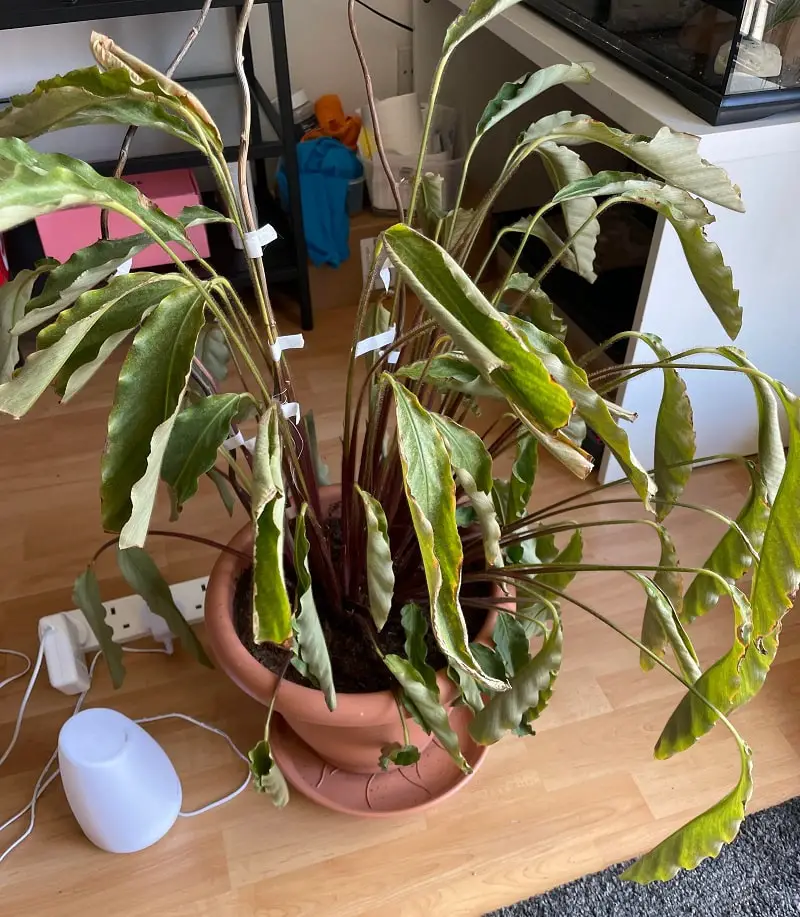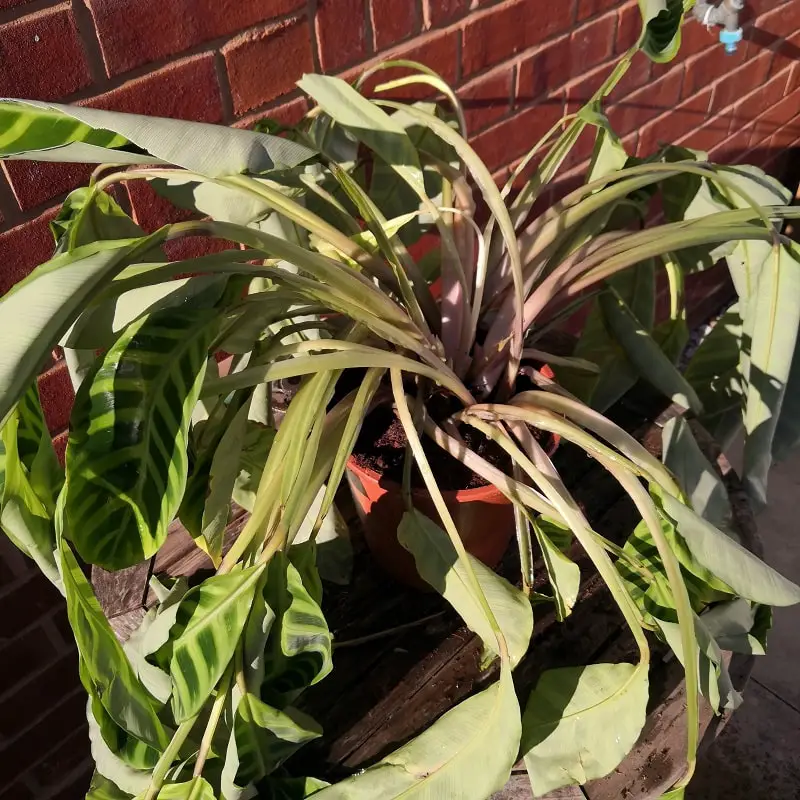Calatheas are incredible and beautiful houseplants worth adding to your collection. But most calathea varieties are more vulnerable to problems. There is no need to freak when your calathea begins to die. I’ll show you how to revive a dying calathea in this article.
So, why is my calathea dying? The possible causes are low humidity, inconsistent watering habits, overwatering leading to root rot, temperature stress, pests, diseases, water quality, direct sunlight exposure, and over-fertilization.
This article will help you identify the causes and learn how to save a dying calathea plant. Take the time to read through it and learn how to revive a dying calathea. I’ve also mentioned tips for keeping your calathea plant in perfect condition.
You May Also Like: Why Is My Begonia Wilting?

10 Reasons Why Your Calathea Plant Is Dying
Inconsistent Watering Habits
Underwatering is the leading cause of calathea dying. It is super easy to detect underwatered calathea due to wilting and dry soil feeling.
If the condition persists, your calathea leaves will start turning yellow and eventually brown. Reviving the houseplant due to severe underwatering could prove to be challenging.
Inappropriate watering and hot weather are some of the factors that make your houseplant use a lot of water. Root-bound is another factor that fosters frequent watering among these plants.
Consider watering the potting mix to save calathea from dying. Poke the index finger in the soil to feel moisture. Soak the soil with adequate water until it runs out through the drainage holes.
Overwatering Problem
Overwatering is among the leading cause of calathea death. It occurs due to improper soil drainage and a lack of drainage holes at the bottom of the container.
Water-logging inhibits roots aeration and results in root rot. The root fungal disease causes yellow leaves, wilting foliages, brown leaf tips, and a foul smell from the potting mix.
The best option is to remove the houseplant from the pot and inspect the roots. Use a sterilized pruner to remove any signs of root rot. Replant it in a fresh potting mix and offer ultimate care.
Lack of Humidity
Calatheas thrive in a warm and humid climate. High humidity enables the plant to develop stunning foliages and foster upright posture.
Most calathea types cannot cope with humidity below 40%. Some species will even begin showing signs of stress when exposed to humidity below 60%.
If the calathea leaves are turning brown along the edges and tips, low humidity is the main culprit. The brown patches will begin to spread all over and eventually the plant dies.
I recommend installing a digital hygrometer to detect the humidity changes. Consider misting the leaves when the humidity level drops. It will help to revive the dying calathea.
Inappropriate Lighting Condition
Calatheas prefer medium to bright indirect sunlight. Incorrect lighting conditions could be responsible for the dying calathea plant.
Excess direct sunlight usually scorches the leaves and enhances faster dehydration. If the condition persists for a few days, your calathea will eventually die.
Low lighting conditions will also kill your houseplant. The condition inhibits proper growth and increases the risk of overwatering.
The best solution is to consider changing the current location of the indoor plant. Ensure the new location receives bright indirect sunlight to enhance smooth physiological processes.
You May Also Enjoy: How to Care for Calathea Orbifolia Plant
Temperature Stress
If your indoor plant is developing brown leaf tips or edges and wilting, temperature stress is the potential cause of the problem.
Calatheas cannot cope with extreme and fluctuating indoor temperatures. It would be best to ensure the indoor temperature mimics their natural habitat.
Keep in mind that calatheas flourish under a temperature range of 64-75oF (18-24oC). Any temperature below 50oF and above 80oF will cause a considerable amount of stress to the plant.
Consider buying a digital thermometer to help in detecting temperature changes. The technique will help to avoid the calathea plant from dying due to temperature stress.
Pest Infestations
Calatheas are more vulnerable to insect infestations. Spider mites and mealybugs are the most common pests infesting the houseplant.
These insects can severely damage your houseplant through piercing venom and damaging vital tissues. Several pest infestations could lead to wilting and death of calathea plants.
Inspect the leaves and stems of the plant thoroughly. If you notice white or brown dots and wispy webs, it is a clear indicator of pest infestations.
Isolate the houseplant from others to prevent the spread of pests. Use either neem oil spray or isopropyl alcohol to eliminate the pests.
Calathea Plant Diseases
Both fungal and bacterial diseases can kill calathea plants. Examples of these plant diseases are leaf blight and fusarium wilt.
Leaf blight causes the development of brown spots or patches across the foliages. The condition discolored the leaves which later curl and die.
Fusarium wilt usually invades the roots to cause yellowing of leaves and wilting. The fungal disease affects both young and old leaves.
Use a fungicide to treat fusarium wilt and neem oil spray to prevent leaf blight. Be sure to provide ultimate calathea plant care and isolate the houseplant from others.
Water Quality
Tap water is highly mineralized. The chemical compounds in the water may end up killing the houseplant in the long run. Calatheas are super insensitive to minerals and can’t cope with them.
If you notice the leaf tips and edges of your calathea crisping, water quality could be the main problem. The crisping tips usually spread slowly until the whole leaf is affected.
If you ignore the issue, your calathea will eventually die. I recommend watering your houseplant with filtered water. Rainwater is another excellent alternative to consider.
Over-fertilization
Over-fertilization may result in stunted growth. Besides that, excessive salt accumulation around the calathea roots may become toxic and kill the plant.
Too much salt around the roots inhibits water absorption. Dehydration ends up causing wilting and eventually death of the plant.
The best option is to use homemade houseplant fertilizer during summer, spring, and fall. The growing condition allows the plant to utilize all the nutrients.
Transplant Shock
Calatheas are more vulnerable to the root-bound problem. Re-potting the plant every two years is highly recommended to avoid the root-bound issue.
The roots of these houseplants are very sensitive to disturbances. Re-potting the plant will result in transplant shock. The condition makes the roots temporarily cease to function.
The plant will become dehydrated due to a lack of water. Fixing transplant shock in calathea is super easy. You’ll need to supply the plant with plenty of water and provide proper care.
You May Also Like: 15 Best Calathea Varieties with Pictures and Names
Related Questions
Why Are My Calathea Leaves Turning Brown and Crispy?
Low humidity around the plant is the leading cause of leaves turning brown and crispy. Other possible causes are under-watering, overwatering, and exposure to extreme temperatures.
Why Are My Calathea Stems Drooping?
Overwatering is the leading cause of calathea stems drooping. But cold temperature and exposure to drafts could also contribute to the problem.
Why Is My Calathea Turning Yellow?
Calathea leaves and stems turning yellow is due to inappropriate lighting conditions. Other possible causes are overwatering and inconsistent watering habits.
How Often Should You Water a Calathea?
About once or twice a week. But check the soil moisture content level before watering the houseplant. I recommend watering the plant less frequently in winter due to the dormancy stage.
How to Fix Overwatered Calathea?
- Unpot the houseplant and inspect the roots for signs of root rot
- Use sterilized scissors to cut the damaged roots
- Remove all the soil around the remaining roots
- Replant the calathea in a fresh potting mix
- Develop a watering schedule to avoid overwatering
- Provide ultimate calathea plant care regime
You May Also Like: Why Is My Umbrella Plant Drooping?

In Conclusion
Keeping calatheas healthy is not a walk in the plant. The houseplant is more vulnerable to problems and can be fussy at some point. Exercise ultimate calathea plant care routine for a better result in the long run.
If you notice your calathea dying, consider identifying the causes at the early stages. It will make the fixing steps a little bit easier. But if the problem persists, it will be challenging to revive a dying calathea plant.
I hope the information mentioned above will help to save your dying calathea plant. Keep in mind that the causes and solutions apply to all calathea varieties. The tips highlighted will help you to prevent your calathea from dying.
You May Also Read: How to Care for Calathea Musaica